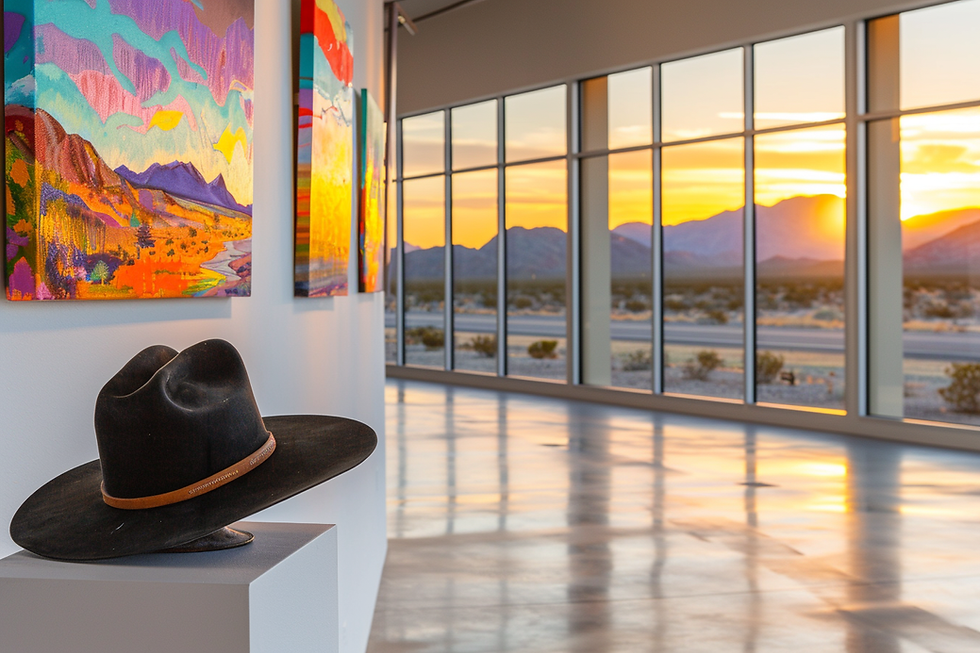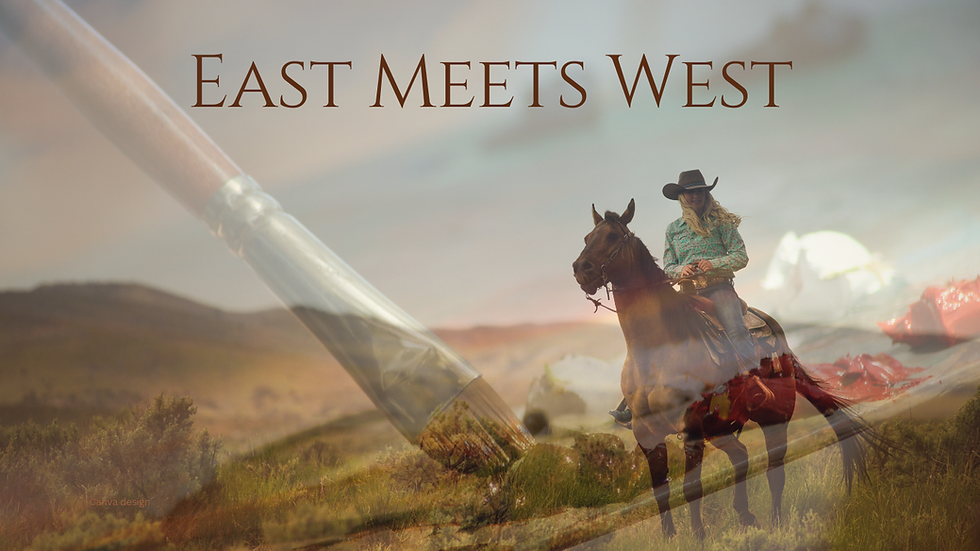Across Open Sky
- Mina Beckett

- Aug 27
- 4 min read
Western icons with a contemporary pulse

Modern Western art still holds the images we know and love. The weathered cowboys under endless horizons and wild horses across open desert. Yet the work speaks with a fresh voice. It honors what came before and reaches for what comes next. The rugged beauty that shaped the genre still stands, now lit by new eyes and guided by craft that feels both timeless and current.
This moment suits the West. Social media favors strong images and true stories. Television has fallen in love again with the sweep of the prairie and the hard choice made at dusk. Audiences want the strength and honesty of Western imagery, only tempered with modern grace. Artists answer with clarity and nerve. Some pare the language down to line and space, letting silence and light carry the story. Others lean into digital tools to reimagine ranch life and desert light with a look that feels futuristic and rooted all at once.
There's something irresistible happening when classic frontier imagery meets contemporary innovation. Artists are discovering that those timeless Western themes don't need to be preserved in amber. They can evolve, breathe, and speak to modern hearts without losing their essential power. The rugged beauty that defined Western art for generations is still there, but now it's enhanced by fresh perspectives and cutting-edge techniques.
Audiences are hungry for this aesthetic. They're drawn to the authenticity and strength that Western imagery represents, but they want it served with contemporary sophistication. Artists are responding with remarkable creativity. Some are stripping Western themes down to their essential elements, creating minimalist pieces that capture the vastness and solitude of frontier life through clean lines and subtle power.
The environmental consciousness movement has found its way into this Western revival too, with artists creating installations that celebrate the land while addressing its fragility. These aren't your grandfather's Western paintings. They're sophisticated works that can hold their own in the most contemporary spaces while carrying forward the spirit that made Western art legendary. What's emerging is a genre that refuses to be confined to ranch houses and rustic lodges.
Today's Western-inspired art belongs in sleek city apartments and modern galleries, proving that some stories are too powerful to be limited by setting or era. Western art carries stories in every brushstroke, stories that stretch back through generations of artists who fell under the spell of America's frontier spirit. This isn't just artistic evolution we're talking about. It's a love affair that's been brewing for centuries.
The legacy runs deep. The traditional masters understood something profound about the American West. They saw beyond the harsh realities of frontier life to capture something deeper—the raw beauty of endless landscapes, the complex dignity of Native American culture, the quiet heroism of ranch life. These artists painted with reverence, creating works that didn't just depict the West but embodied its very soul through realistic detail and rich narrative layers.
What makes today's Western art so compelling is how contemporary artists have inherited this legacy and made it their own. They're not content to simply copy what came before. They're having their own passionate affair with Western themes, bringing modern techniques and fresh perspectives to age-old subjects.
I love the work of Donna Howell Sickles. Her cowgirls stride through the canvas with bright scarves, steady hands, and a gaze that does not look away. Color blazes through warm oranges and earth tones against a clear sky, while sure lines frame everything from a patterned border to the tilt of a chin. In a single look or the tug of a bridle she gives you resolve, joy, and the comfort of belonging.
The title, Careful, I Keep What I Catch says exactly what her pictures do. They claim their ground. Her voice is generous and bold, joining classic Western subjects with clean contemporary design. The paintings live as easily in a ranch house as they do in a white walled gallery because truth fits both.
Pretty Shield, Medicine Woman of the Crows, meets you at the threshold and holds you there. Jeremy Winborg guides the eye to the luminous face, the shell cupping a blue ember, the pale thread of smoke. Sunlight freckles her cheek. A breeze lifts a strand of hair. Mirrored earrings catch and keep the light.
Behind her, a storm of paint hums with knife sliced passages and broken brush in earth and sky tones, yet never drowns the voice at the center. The hands are sure. The gaze is steady. Even the air seems to move. This is his way, portrait truth set against modern color fields. He favors saturated reds, notes of turquoise, and skin that glows, often placing contemporary Indigenous sitters in traditional regalia against layered grounds. Texture balances calm, depth meets clarity, and detail is chosen with care so intimacy arrives quiet and certain. The result is dignified and celebratory, stories of identity and endurance held on the breath.
Western art has brushed the dust from its boots. It still knows the curve of a ridgeline and the weight of a saddle, and it refuses to live only there. It's evolving, branching out and its beautiful. Artists from many places stitch abstraction, concept, and installation into the fabric so the familiar opens in unexpected ways. History rides with change. Hard truths join the table. Old myths are unpicked and reworked into a larger conversation where Western techniques meet local traditions and the seams hold questions of identity, power, and justice. In that meeting the genre finds its future. Not a relic. A living language with heat and heart and he capacity to evolve.
Look long enough and you can hear it breathe. The hush of desert dusk. The thunder of horses. The lift of a mountain against a clear sky. This is art that remembers, and art that reaches. It keeps the cowboy’s mettle and the honest weight of work. It carries Indigenous geometry and story with respect so past and present can speak to each other.
It asks us to stand still, to look again, to feel the old song and the new note. Then it sends us on our way, a little steadier, a little braver, with the West still moving beside us.



Comments